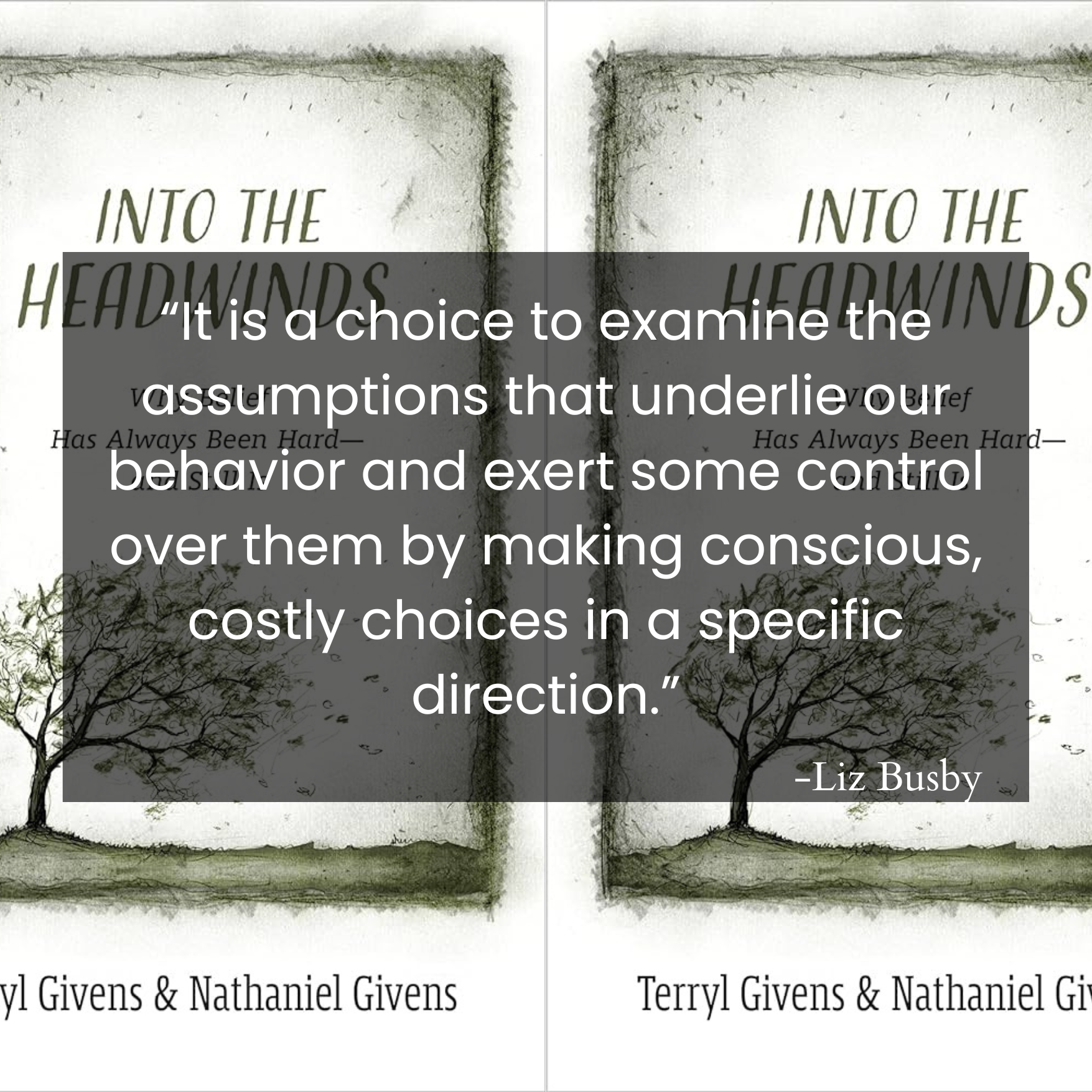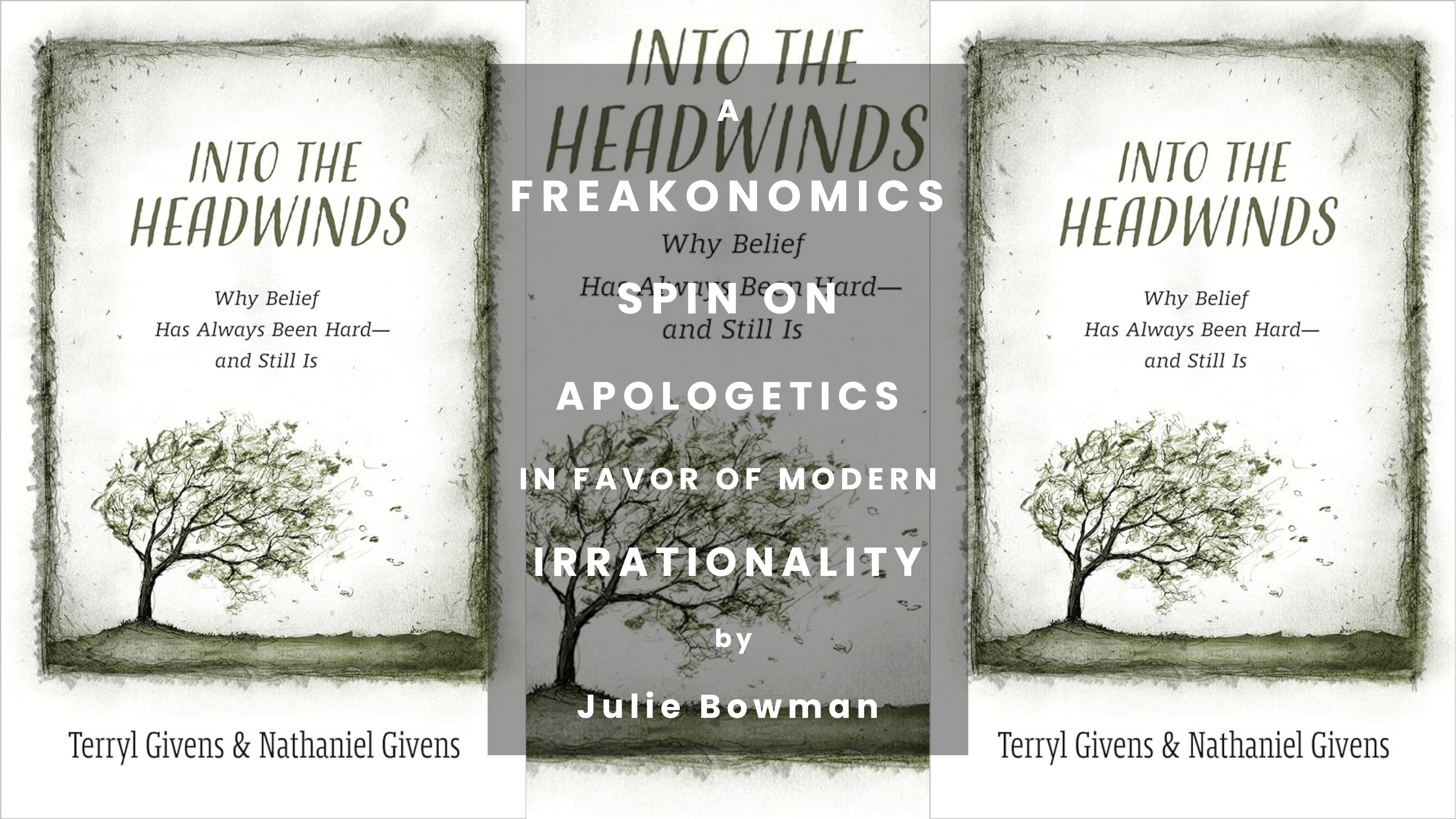Articles/Essays – Volume 57, No. 1
A Freakonomics Spin on Apologetics in Favor of Modern Irrationality | Terryl Givens and Nathaniel Givens, Into the Headwinds: Why Belief Has Always Been Hard—and Still Is
When I received a review copy of Terryl and Nathaniel Givens’ new book Into the Headwinds: Why Belief Has Always Been Hard—and Still Is, I was warned by the author that as a book about faith, it was unusual. As I dug into the short volume, I found this to be true: rather than a general audience religion book, it read more like Freakonomics than anything else. The book rarely cites scripture or doctrine and is focused on evidence from neuroscience, psychology, and economics to support its argument about the nature of belief in the modern world.
Into the Headwinds is written for a general audience and divided into an introduction and three sections. The introduction, titled “Secularism Is Not the Problem,” argues against the claim that scientific progress makes religion obsolete, dubbed “the secularism hypothesis.” The authors object to the characterization of humans before the Age of Reason as more credulous and therefore vulnerable to supernatural beliefs, pointing out contemporary skepticism about early Christian claims about the resurrection on one end and the conspiracy theories that continue to thrive in the modern era on the other.
“On Rationalism” covers recent advances in neuroscience, sociology, and behavioral economics to dismantle the idea that humans are essentially rational creatures. Though they cite the work of Daniel Kahneman and Amos Tversky, Richard Thaler, and others, this section relies most heavily on Johnathan Haidt’s analogy of the “divided self,” represented as an instinctual elephant and a logical rider, with the rider coming up with post hoc moral explanations for the elephant’s behavioral choices. From this evidence base, the authors argue that seeing faith as a system of beliefs makes little sense since “we are generally in the disappointing position of neither knowing what we believe nor why we believe those things with any reliability” (49).
The chapter “On Scientism” attacks the idea that science is the only tool for understanding anything worth knowing about the universe. The authors point out that many of the major discoveries in history required an intuitive leap not backed by the scientific method until afterward. The reality of science as “messy affair, full of blind alleys and abandoned digressions” (64) contradicts the popular notion of science as a straightforward progression toward truth. In fact, science relies on the assumed ability of human beings to reason, which remains unprovable in any scientific manner. Indeed, the authors conclude that science and religion are not “nonoverlapping magesteria,” but rather “spring from the same root desire to know” (76).
The final chapter, “On Faith,” brings us back to the titular “headwinds” that make faith difficult in the modern age. The authors enumerate the various cultural, biological, and psychological barriers to a vibrant faith in the modern age. After presenting these obstacles, they point out that there is no escape from belief: “We cannot decide, in the general sense, to believe or not. We can only decide what to believe and, even more fundamentally than that, why and how to believe” (100). The final section presents faith as a moral reaction to perceived truths. It is a choice to examine the assumptions that underlie our behavior and exert some control over them by making conscious, costly choices in a specific direction.

As a generalist reader, I found in this book a fascinating application of concepts I met in other popular science texts to the problem of faith in the modern age. Some arguments are a little fast and loose, as might be expected from a book scarcely over one hundred pages attempting to cover so many disciplines. I found the authors’ quick gloss over the issue of the mechanism of creation unsatisfactory, even as someone thoroughly convinced that evolution was involved in the creative process. The authors try to sidestep the issue by stating that “whether or not God created humans through directed evolution, literally from the dust of the earth, or by some other method, as biological organisms, we fit within the paradigm of evolution through natural selection” (45). Though technically supportive of evolution, this seemed like a concession to creationists that undermined much of the rest of the argument of the book, which relies heavily on psychological errors induced at least in part by their utility in natural selection.
An additional interesting point is the unusual position of this book in the marketplace. Into the Headwinds is being published as a work of popular apologetics by mainstream Christian publisher Eerdmans. In the book as it exists, I found only one explicit reference to Latter-day Saint history as an example of the desire for belief in concrete things (97), and a more oblique reference in a narrative quoted from Elna Baker, a producer at This American Life and a former member of the LDS Church (107). Though it may not be the only LDS book to make this jump, it’s the only one I could find published by Eerdmans. A brief search of their catalog reveals only one other Mormon-authored book, Craig Harline’s 2021 mission memoir Way Below the Angels, which is explicitly marked as LDS.
The reason this book could make the leap to a general audience is clear: almost nothing in this book is exclusive to the LDS faith. In fact, much of the book is not even specific to the Christian faith. Instead, Terryl and Nathaniel Givens build a rational argument for the importance and continued relevance of the irrational in an age where many assume logic and science to be the highest ideal. Yet the book’s desire to incorporate truth from many scientific fields with religious belief into “one great whole” seems like a particularly Latter-day Saint impulse. Though I could wish for a future edition of this book that might dive deeper into the specifically LDS implications, the argument for the harmony of science and religion as interdependent methods of seeking truth resonated with my own beliefs. For those who likewise seek to embrace both rational and irrational truths, Into the Headwinds provides a foundation for an explanation of modern faith.
Terryl Givens and Nathaniel Givens. Into the Headwinds: Why Belief Has Always Been Hard—and Still Is. Grand Rapids, Mich.: Eerdmans, 2022. 140 pp. ISBN: 0802882439.


 Back to full Issue
Back to full Issue

